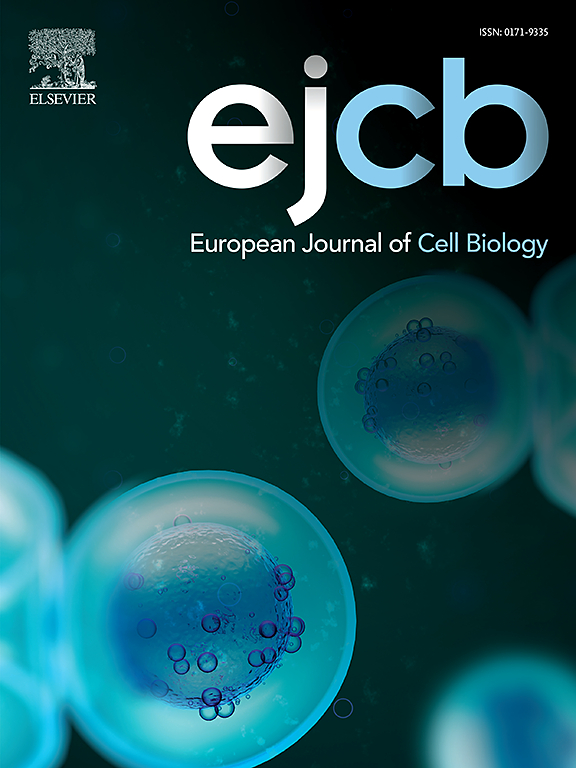Versatility of vimentin assemblies: From filaments to biomolecular condensates and back
IF 4.3
3区 生物学
Q2 CELL BIOLOGY
引用次数: 0
Abstract
Cytoskeletal structures shape and confer resistance to cells. The intermediate filament protein vimentin forms versatile structures that play key roles in cytoskeletal crosstalk, in the integration of cellular responses to a variety of external and internal cues, and in the defense against stress. Such multifaceted roles can be fulfilled thanks to the vast variety of vimentin proteoforms, which in turn arise from the combinations of a myriad of tightly regulated posttranslational modifications. Diverse vimentin proteoforms will differentially shape its polymeric assemblies, underlying vimentin ability to organize in filaments, bundles, squiggles, droplets, cell surface-bound and/or various secreted forms. Interestingly, certain vimentin dots or droplets have been lately categorized as biomolecular condensates. Biomolecular condensates are phase-separated membraneless structures that are critical for the organization of cellular components and play important roles in pathophysiology. Recent findings have unveiled the importance of low complexity sequence domains in vimentin filament assembly. Moreover, several oxidants trigger the transition of vimentin filaments into phase-separated biomolecular condensates, a reversible process that may provide clues on the role of condensates as seeds for filament formation. Revisiting previous results in the light of recent knowledge prompts the hypothesis that vimentin condensates could play a role in traffic of filament precursors, cytoskeletal crosstalk and cellular responses to stress. Deciphering the “vimentin posttranslational modification code”, that is, the structure-function relationships of vimentin proteoforms, constitutes a major challenge to understand the regulation of vimentin behavior and its multiple personalities. This will contribute to unveil essential cellular mechanisms and foster novel opportunities for drug discovery.
静脉蛋白组装的多功能性:从细丝到生物分子凝聚体再回来
细胞骨架结构形成并赋予细胞抵抗力。中间丝蛋白波形蛋白形成多种多样的结构,在细胞骨架串扰中发挥关键作用,在细胞对各种外部和内部信号的反应整合中发挥关键作用,并在抵抗压力方面发挥关键作用。这种多面性的作用可以通过多种多样的蛋白形态来实现,而这些蛋白形态又源于无数严格调控的翻译后修饰的组合。不同的波形蛋白会形成不同的聚合物组合,从而使波形蛋白能够以丝状、束状、卷曲状、液滴状、细胞表面结合和/或各种分泌形式组织。有趣的是,某些波形蛋白点或液滴最近被归类为生物分子凝聚物。生物分子凝聚体是一种相分离的无膜结构,对细胞成分的组织至关重要,在病理生理中起着重要作用。最近的研究结果揭示了低复杂性序列域在静脉蛋白细丝组装中的重要性。此外,几种氧化剂触发了vimentin细丝向相分离的生物分子凝析物的转变,这一可逆过程可能为凝析物作为细丝形成种子的作用提供线索。根据最近的知识,回顾以前的结果提示了一个假设,即波形蛋白凝聚物可能在丝前体的运输、细胞骨架串扰和细胞对应激的反应中发挥作用。破解“弧菌蛋白翻译后修饰密码”,即弧菌蛋白的结构-功能关系,是理解弧菌蛋白行为调控及其多重人格的重大挑战。这将有助于揭示基本的细胞机制,并为药物发现创造新的机会。
本文章由计算机程序翻译,如有差异,请以英文原文为准。
求助全文
约1分钟内获得全文
求助全文
来源期刊

European journal of cell biology
生物-细胞生物学
CiteScore
7.30
自引率
1.50%
发文量
80
审稿时长
38 days
期刊介绍:
The European Journal of Cell Biology, a journal of experimental cell investigation, publishes reviews, original articles and short communications on the structure, function and macromolecular organization of cells and cell components. Contributions focusing on cellular dynamics, motility and differentiation, particularly if related to cellular biochemistry, molecular biology, immunology, neurobiology, and developmental biology are encouraged. Manuscripts describing significant technical advances are also welcome. In addition, papers dealing with biomedical issues of general interest to cell biologists will be published. Contributions addressing cell biological problems in prokaryotes and plants are also welcome.
 求助内容:
求助内容: 应助结果提醒方式:
应助结果提醒方式:


